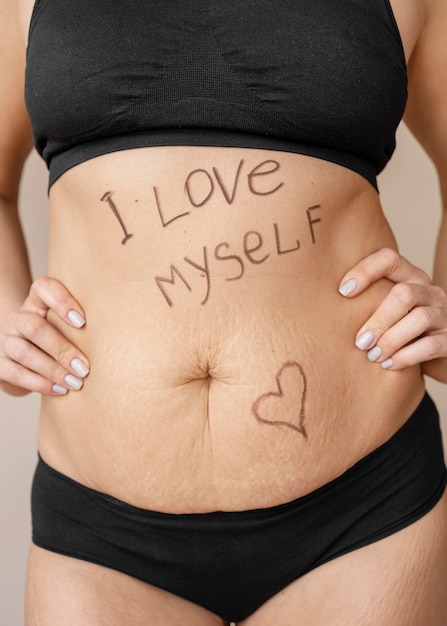
During pregnancy, a woman’s body goes through many changes, and one common change is the development of stretch marks. These marks appear in about 50 to 90 percent of pregnant women. Unfortunately, they often stick around for years, leaving a noticeable effect on the skin. However, the good news is that there are ways to help prevent these marks from forming.
Stretch marks, also called striae gravidarum or striae distensae, look like streaks on the skin, ranging in color from red and purple to silver. They usually show up on the chest, thighs, stomach, hips, and bottom. While anyone can develop stretch marks at any time in life, pregnancy is a particularly high-risk phase due to the significant weight gain that typically affects these areas. The skin stretches rapidly during pregnancy, sometimes leading to small tears in the tissue layers under the surface, which result in these marks. Over time, the marks may fade but rarely disappear completely.
Several factors contribute to the development of stretch marks during pregnancy, including hormonal changes, genetic predisposition, and weight gain. If your mother or grandmother had stretch marks during pregnancy, there’s a good chance you might develop them as well. Women with lighter skin tones tend to have more noticeable stretch marks compared to those with darker skin tones, though they can affect anyone.
If you’re pregnant or planning to be, you can take active steps to reduce your chances of developing stretch marks. Here are some tips to consider:
### Take Action Early
If you notice stretch marks starting to form, don’t wait to address them. While it may not be possible to prevent them entirely, early treatment can significantly reduce their appearance. Consult with a healthcare professional or dermatologist to figure out what’s causing the marks and explore treatments that might help in the long term.
### Stay Hydrated
Drinking plenty of water is key to keeping your skin hydrated, supple, and less prone to stretch marks. Soft, well-hydrated skin is more elastic and less likely to tear under the pressure of stretching. Aim to drink a daily recommended amount of water, and avoid dehydrating drinks like coffee. If you have caffeinated beverages, make up for it by drinking extra water or other hydrating options like coconut water or herbal tea.
### Manage Your Weight
Rapid or excessive weight gain during pregnancy is one of the main causes of stretch marks. To reduce this risk, try to maintain a steady, gradual weight gain that’s appropriate for your pregnancy. This can be achieved by eating smaller, nutrient-rich meals throughout the day rather than larger portions, and by sticking to a healthy diet paired with regular exercise. Monitoring your weight gain will not only help your skin but also support your overall health during and after pregnancy.
### Eat a Nutrient-Dense Diet
A balanced diet rich in essential vitamins and minerals can help strengthen your skin from the inside out. Focus on foods high in Vitamin C (found in citrus fruits), Vitamin D, Vitamin E, protein, and zinc. These nutrients boost skin elasticity and repair, reducing the risk of stretch marks. Include a variety of colorful fruits, vegetables, nuts, eggs, and whole grains in your daily diet to ensure your skin gets the nutrients it needs.
### Moisturize Regularly
Applying a rich moisturizer, such as cocoa butter, aloe vera, or specially formulated creams for pregnancy, can help keep your skin hydrated and more elastic. Aim to moisturize your skin at least twice a day, focusing on areas prone to stretch marks like your stomach, thighs, hips, and chest. For best results, apply moisturizer right after a shower when the skin is slightly damp to lock in hydration.
### Get Enough Vitamin D
Studies suggest a link between low Vitamin D levels and stretch marks. Soaking in a little sunlight early in the morning can help your body naturally produce this important vitamin. However, don’t overdo it, as prolonged sun exposure can harm your skin. You can also opt for Vitamin D-rich foods or supplements to ensure your body gets its daily requirement.
### Add Vitamin C to Your Diet
Vitamin C plays a key role in collagen production, which helps keep the skin firm and elastic. Collagen protects your skin as it stretches, minimizing the chance of tearing. You can get Vitamin C from various fruits and vegetables, including lemons, oranges, and berries. Adding these foods to your meals can go a long way in keeping stretch marks at bay.
### Include Zinc-Rich Foods
Zinc is another essential nutrient for healthy skin. It promotes wound healing and reduces inflammation, which can help your skin recover from the small tears that cause stretch marks. Foods like nuts, seeds, fish, and whole grains are great sources of zinc.
### Massage Your Skin
Gently massaging stretch mark-prone areas with a cream or oil can enhance the skin’s elasticity and improve blood circulation. Massage also helps deliver the moisturizing product deeper into the skin. Spend about 10 minutes massaging target areas daily for the best results.
### Exfoliate Once a Week
Weekly exfoliation can help remove dead skin cells, allowing moisturizing products to penetrate better and work more effectively. This also helps with cell regeneration and may reduce early stretch mark appearance. Focus on areas like the stomach, thighs, hips, and chest when exfoliating.
Beyond these steps, protecting your skin from harmful UV rays, quitting smoking, and incorporating light exercises like walking or yoga can also improve skin health and circulation during pregnancy. With consistent effort and these preventive measures, you can reduce the risk and visibility of stretch marks during this transformative phase of life.